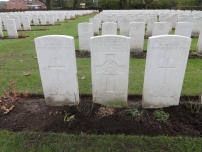| First Name: | George Albert | Last Name: | SWAIN | |
|---|---|---|---|---|
| Date of Death: | 20/10/1914 | Lived/Born In: | Dalston | |
| Rank: | Private | Unit: | Lancashire Fusiliers2 | |
| Memorial Site: | Stoke Newington Library | |||
Current Information:77, Albion Road, Stoke Newington Strand Military Cemetery, Ploegsteert, Belgium
The Race to the Sea - September-October 1914 By the middle of September 1914, the Aisne battlefield had stagnated into trench warfare and in order to break this impasse, both sides tried to outflank each other in a general movement northwards. Moving up through Picardy, Artois & Flanders, the race was over by 19th October when the North Sea was reached. The Western Front, a line of trenches stretching from Belgium to Switzerland, was now a reality. Initially it was the French army that conducted this movement whilst the British Expeditionary Force remained on the Aisne but by 6 October British reinforcements were needed to help beat off German attacks around Lille. They moved north and along with reinforcements from Britain, they took up new positions in Flanders, on the left of the Allied line and much closer to the Channel ports. The Battle of Messines - 12th October-2nd November 1914 The Battle of Messines was one of the actions that took place during the Race to the Sea and it took place between the Comines-Ypres canal and the River Douvre. It involved the 1st and 2nd Cavalry Divisions and elements of the 3rd, 4th and 5th Divisions as well part of the Indian Division. The 2nd Lancashire Fusiliers battalion of 12 Brigade, 4th Division arrived by train at Hazebrouck on 13th October and by 17th October were in positions near Ploegsteert. At 6.30am on 18th October, 4th Division moved forward towards Frélinghien with 12 Brigade advancing along both banks of the River Lys towards their objective, the village of Le Touquet. The German front line in front of Lille did not run straight north as presumed at first but turned west at Verlinghem and ran to Frélinghien before continuing north along the river. This meant that the attack was bound to be enfiladed from the main enemy front line as indeed it was. With 1st Royal Lancaster and 2nd Lancashire Fusiliers leading, 12 Brigade reached the railway without meeting resistance but once across it came under heavy fire from front and flank. Nevertheless their attack continued and eventually nearly all of Le Touquet had been captured. There were of course a number of casualties for the battalion including George Swain who died from wounds on 20th October. |
||||
| « Back to Search Results | ||||
| If you think any of the information shown here is incorrect, Click Here to submit your amends and comments | ||||




